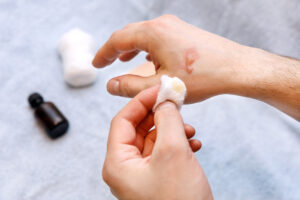Whether to Treat Your Own Burn Injury or Seek Medical Attention
 Burn injuries are a relatively common occurrence, even more so in summer. You might put your hand down on a hot grill, step on a hot coal near a campfire, or suffer a burn shooting off fireworks. Many burns are superficial and cause only temporary pain. Those are commonly referred to as first-degree burns. You can generally immerse such burns in cold water or apply a cold compress, and you should be fine within a few hours.
Burn injuries are a relatively common occurrence, even more so in summer. You might put your hand down on a hot grill, step on a hot coal near a campfire, or suffer a burn shooting off fireworks. Many burns are superficial and cause only temporary pain. Those are commonly referred to as first-degree burns. You can generally immerse such burns in cold water or apply a cold compress, and you should be fine within a few hours.
With a more serious burn, it’s a good idea to seek medical care. What are the telltale indications that a burn should be treated by a medical professional?
The Different Types of Serious Burn Injuries
First-degree burns generally affect only the outermost layer of skin.
When a burn injury compromises the next layer of skin, known as the dermis, it’s considered to be at least a second-degree burn. You may develop blistering from a second-degree burn, or you might just have red, white, or splotchy spots on your skin.
If the burn goes below the dermis to the fat layer, it’s considered a third-degree burn. These types of burn injuries can damage or destroy nerves and may leave your skin looking leathery. The most heavily damaged areas will typically appear white, brown, or black.
When Should You Go to the Hospital or Contact Your Doctor?
Certain burns require emergency care while others can wait until you’re able to get into your doctor’s office. In general, though, it’s better to get treatment as soon as possible. Here are the clear indications that you need medical care:
- Your skin has a leathery appearance (indicating a 3rd-degree burn).
- You’re having difficulty breathing, or you have any type of burn to the inside of your throat or airway.
- You have burns that cover an entire area of your body, such as a hand or foot, your buttocks, face, or a major joint.
- You have suffered any type of electrical burn.
- It’s clear that the burns have penetrated into the fat layer on your body.
Other warning signs that you need medical care include any indication of infection, such as heat, swelling, or redness around a burn; oozing; or increased pain. If you have a particularly large blister, or one that takes more than a couple weeks to heal, you should have it treated by a medical professional.

